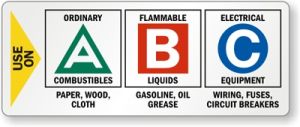Did you know that the fire department responds to a fire every 23 seconds and 8 people per day lose their lives to fires in the United States. And that most fires at home start in the kitchen. As a firefighter for over 3 decades, I responded to my fair share of kitchen fires. But it doesn’t matter where the fire starts or how it starts. Extinguishing the fire is the same. We are going to keep it simple and real world as we give some simple steps and strategies to keep you and your family safe.
So some good news first. All fires start small and are easy to extinguish, if you have the right tool. The bad news is, fire doubles in size every minute and spreads quickly. So to be effective you have to have a fire extinguisher close by. Again this means you need to be prepared. Are you beginning to see a theme with me yet? Just go to Costco or a Home Improvement store and get one today.
How To Use a Fire Extinguisher (Fire Extinguisher Training)
Having a fire extinguisher and knowing how to use it would be an invaluable life-saving tool and skill that could help minimize risk to your life and property. It is simple to use, once you know how it works. I am not going to make you a firefighter in the next 60 seconds but I am going to make you more comfortable.
But first things first. If you are going to go shopping what kind of extinguisher should you buy. The most common is the dry chemical extinguisher and for good reasons. It will extinguish the common three classes of fires.
Fire Extinguisher Class

A -for ordinary combustibles. Paper, wood, cloth, basically all non-metals. That is anything that burns and leaves an ash (A for Ash).
B– flammable liquids. Gasoline, oil, grease. Of course they come in barrels (B for Barrel).
C– electrical fires. Anything that is plugged in. And electricity carries a electrical charge (C for Charge)
Look for these 3 Letters A B C on your extinguisher. It is the best universal extinguisher for Home, Cars, Boats, RV’s and Businesses. You can get a Halon extinguisher, which are great for expensive electrical equipment, computers, tape, etc. but it does not perform well outside or for some class A type fires.
Where to put the Fire Extinguisher
Now that you have your extinguisher, mount it where you have easy access to it. At home this would be somewhere in the kitchen, but not in that cabinet over the stove. I know, crazy huh. I can’t count on my hands how many fires I went to where people who actually had a fire extinguisher, stored it in the worst place possible for a stove fire.
How to use your extinguisher in an emergency or disaster.
First call 9-1-1 and get the fire engine on the way, then grab your extinguisher and check the gauge to make sure the needle is in the green. This tells us that the extinguisher is charged with nitrogen an inert gas that will blow the powder out of the extinguisher and onto your fire. Your now ready to GO!
Next we refer to that acronym P A S S
Pull the pin
Aim at the base of the fire
Squeeze the handle and
Sweep side to side, just enough to cover the items burning.
Of course don’t start discharging the extinguisher until you are 8 to 10 feet away. This is about the time you should start to feel the heat. And never start discharging any closer than 5 feet to the burning product or you will blow fire right back on top of yourself. With a 5 lb. extinguisher, one you would typically see at your work, will discharge powder for about 20 seconds. Which may not seem like a long time, but in fire fighting time that is very long time. Most small fires should extinguish in 2-5 seconds.
Once the fire is out, you should remove the burned items to the outside and complete the extinguishment by cooling with water if possible.
Since most fires at home start in kitchen, here are some simple tips for kitchen stove fires. First turn off the flame to the stove, second grab the lid to the pan, hold it directly in front of you (using it as a shield) and simply place it on top of the pan, this will immediately extinguish the fire.
Fire Caution:
- Never use water on grease fires (steam explosion)
- Never use flour (dust explosion)
- Never use a dish towel (it will only add fuel to the fire if you don’t cover the pan completely)


